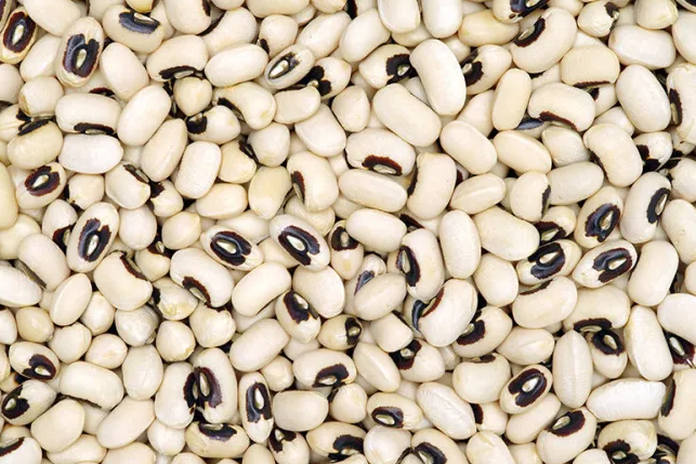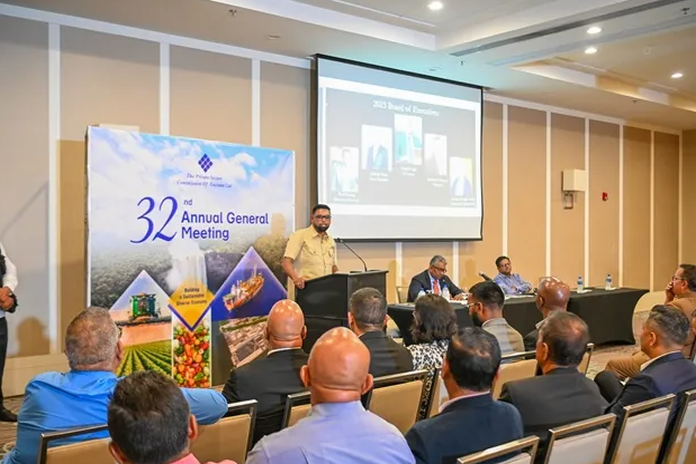GEORGETOWN, Guyana, (DPI) – Guyana will be able to save more than US$150 million in imports for a variety of crops by the end of 2025, due to its crucial planning, execution of developmental projects, and investments in the agriculture sector.
This is according to president Dr Mohamed Irfaan Ali, during his address at the opening ceremony for the Private Sector Commission (PSC) 32nd annual general meeting on Tuesday, at the Marriott Hotel in Kingston, Georgetown.
“People might say ‘You are planting a lot. What does all of this mean for the country?’ It means that we will be saving by the end of next year more than US$150 million of imports. That is what we spend to import onion, corn, soya, feed, black eye and red beans. That is the type of foreign currency impact that we are talking about, when you add the fertiliser, the chemicals, and all of these things that come with that,” the head of state noted. The agriculture sector has grown tremendously over the years and there is no doubt that more investment would be made to ensure it remains sustainable, noting that regional institutions need to do more in integrating these policies that Guyana is heavily building out.
To support this integration, the government is also investing in infrastructure that will have a far-reaching impact on the economy. Importantly, manufacturing will be boosted and the cost of energy will be reduced by 50 per cent as a result of the groundbreaking gas-to-shore energy project.
“Is it going to get harder or easier? It is going to get substantially easier because we are now moving into the other form of energy mix, where we have the gas coming on stream. We will be producing fertiliser here,” president Ali explained.
In order to increase cassava production, the government has a major plan to move towards farine production and refined cassava flour for local and highly specialised markets. With the introduction of a new variety for cassava, the yield has since increased from 15 tonnes to 30 tonnes per hectare. Guyana has reaped over 20 million pounds of cassava so far for 2024.
For the aquaculture sector, the $100 million prawns production project is moving apace at Onverwagt in Region Five. This project is slated to produce 12 tonnes of Vannamei prawns per crop, with each tonne expected to be worth approximately $4 million.
Guyana is also looking to produce all of its livestock feed by October of this year, which will cut the cost by 50 percent.
By the end of 2025, the country will also become self-sufficient in the production of corn and soya.
“We have done this in an environment where we confronted the COVID-19 pandemic for a year and a half. We confronted two major floods and one major drought and we have achieved this. I say this so that we understand and value the type of effort that was placed in us achieving us,” president Ali told participants at the session.

Meanwhile, president Ali announced that Guyana will begin cultivating black eye and red beans on a larger scale within a few days, aiming to satisfy existing local and regional demand for these crops.
“I am going to visit that farm in about three days. The planters and everything are here…So, the small farmers will help to support the local markets,” the head of state disclosed.
The initiative will enable the country to achieve self-sufficiency in black-eye and red beans by the first quarter of 2025.
Furthermore, the undertaking would give Guyana the capacity to supply the two crops to the markets in CARICOM by 2026.
In October 2023, the president unveiled plans to cultivate red beans on 400 acres of land in Baracara Village in Region Six.
Several other massive developmental projects are ongoing to achieve food security locally and regionally.
“Agriculture is our future and this is going to be [a] massive revenue creation for this country,” president Ali emphasised.
Over the years, investments in the agriculture sector have been carefully made to position Guyana as the food hub in the region while reducing the region’s food importation bill.





